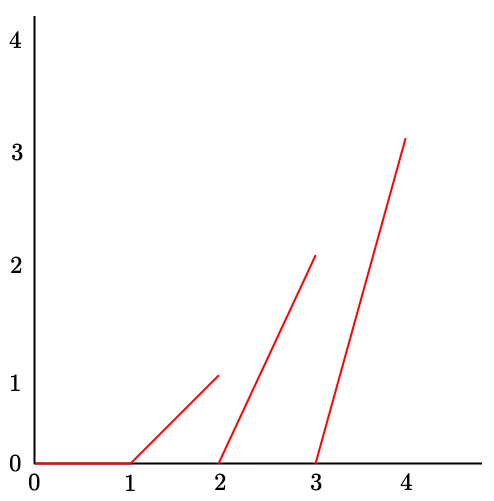Floor+fractional parts
∫ 0 4 { x } ⌊ x ⌋ d x = ?
Notations :
-
{ ⋅ } denotes the fractional part function .
-
⌊ ⋅ ⌋ denotes the floor function .
The answer is 3.
This section requires Javascript.
You are seeing this because something didn't load right. We suggest you, (a) try
refreshing the page, (b) enabling javascript if it is disabled on your browser and,
finally, (c)
loading the
non-javascript version of this page
. We're sorry about the hassle.
4 solutions
the integral above equals
∫ 0 4 x ⌊ x ⌋ d x − ∫ 0 4 ⌊ x ⌋ 2 d x we break the first integral into multiple parts,namely,
∫ 0 1 0 d x + ∫ 1 2 x + ∫ 2 3 2 x d x + ∫ 3 4 3 x d x
and the second integral is the sum of squares of the natural numbers from 0 to 3
making our answer 3
(+1).... But no need to do parts just use definition of { x } and ⌊ x ⌋ in each interval - Just a bit different but same line of thinking...
This question becomes relatively straightforward if we consider the integration as the area under the graph. The graph for
y
=
{
x
}
is like a sawtooth wave, and the graph for
y
=
⌊
x
⌋
is like a staircase - multiplying these together gives a graph with the following shape:
 The integral is simply the area of the three triangles formed.
∫
0
4
{
x
}
⌊
x
⌋
d
x
=
2
1
+
1
+
2
3
=
3
.
The integral is simply the area of the three triangles formed.
∫
0
4
{
x
}
⌊
x
⌋
d
x
=
2
1
+
1
+
2
3
=
3
.
Break them in the intervals of 1 unit and the floor function would reduce to integer and in 1 interval integration of fractional part is always 0.5 hence the answer is ( 1 + 2 + 3 ) × 0 . 5 = 3
I = ∫ 0 4 { x } ⌊ x ⌋ d x = k = 0 ∑ 3 ∫ k k + 1 ( x − k ) k d x = k = 0 ∑ 3 [ 2 k x 2 − k 2 x ] k k + 1 = k = 0 ∑ 3 ( 2 k ( 2 k + 1 ) − k 2 ) = k = 0 ∑ 3 2 k = 2 1 k = 1 ∑ 3 k = 2 ⋅ 2 3 ⋅ 4 = 3